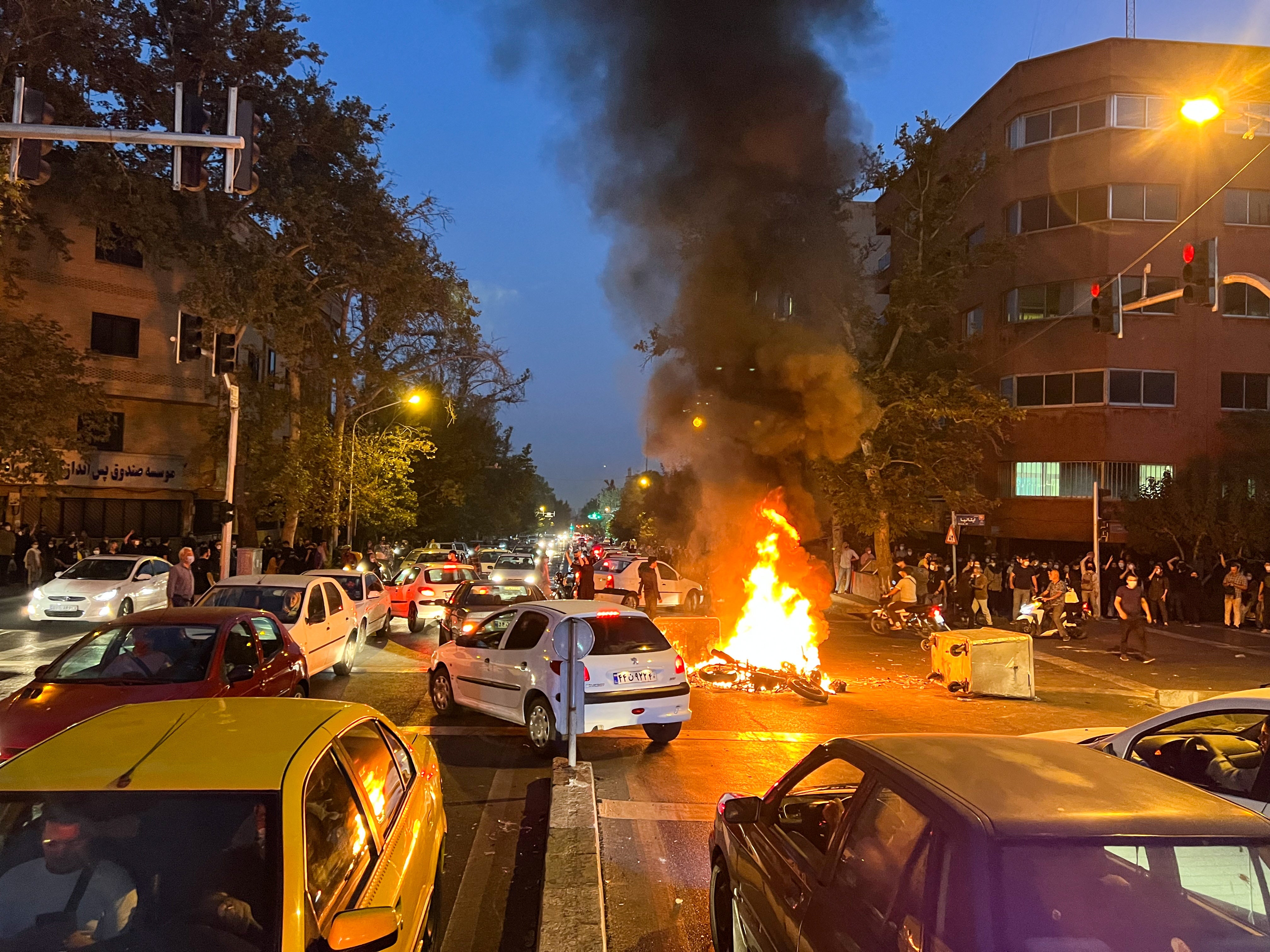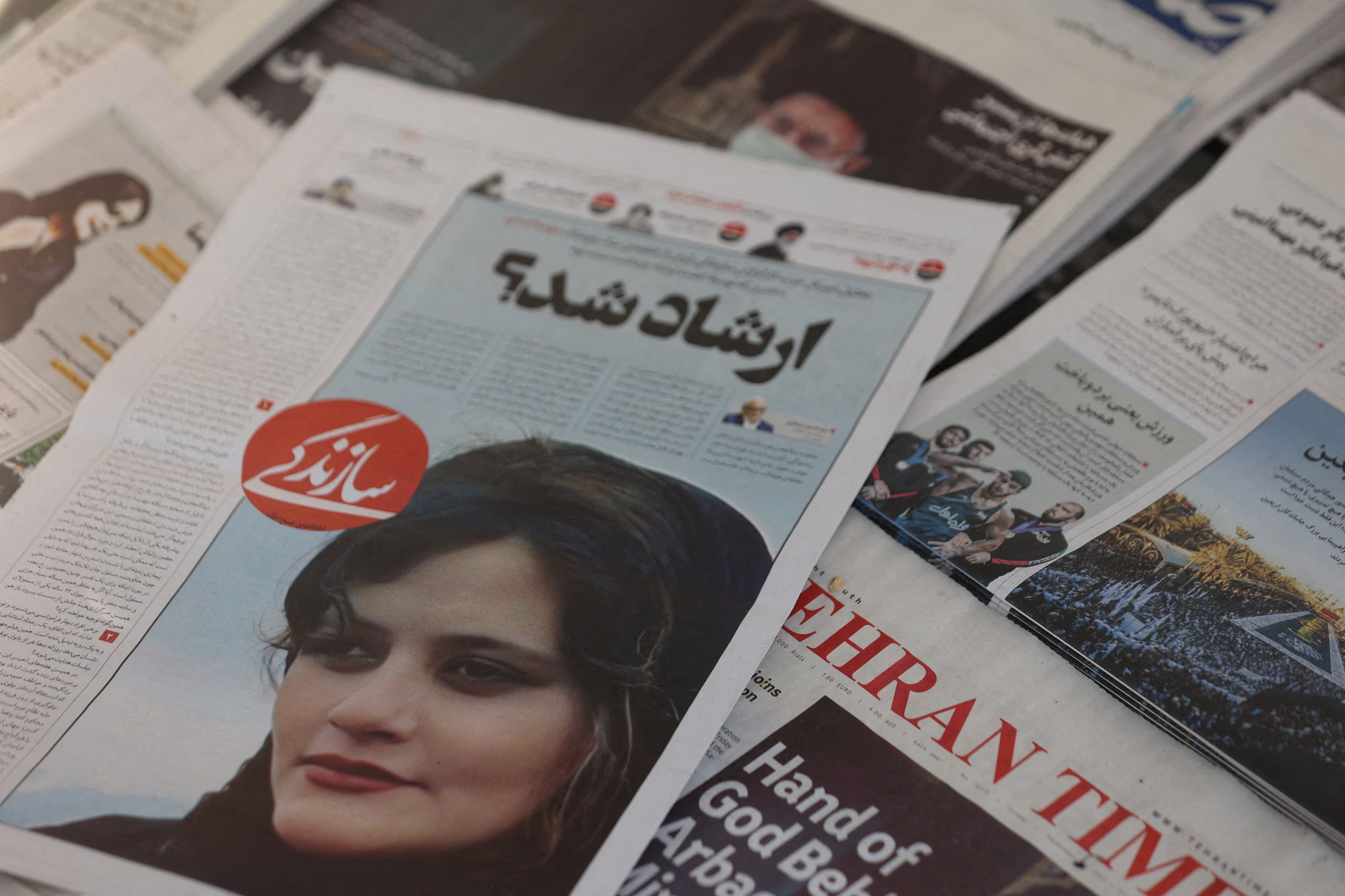A woman’s death fuels a nation’s rage: Iran erupts over 22-year-old who died after hijab arrest
Father alleges Mahsa Amini was assaulted during arrest
Your support helps us to tell the story
From reproductive rights to climate change to Big Tech, The Independent is on the ground when the story is developing. Whether it's investigating the financials of Elon Musk's pro-Trump PAC or producing our latest documentary, 'The A Word', which shines a light on the American women fighting for reproductive rights, we know how important it is to parse out the facts from the messaging.
At such a critical moment in US history, we need reporters on the ground. Your donation allows us to keep sending journalists to speak to both sides of the story.
The Independent is trusted by Americans across the entire political spectrum. And unlike many other quality news outlets, we choose not to lock Americans out of our reporting and analysis with paywalls. We believe quality journalism should be available to everyone, paid for by those who can afford it.
Your support makes all the difference.The death of a 22-year-old woman detained last week by Iran’s morality police for allegedly not wearing proper Islamic hijab has sparked a wave of protests across the country.
The outbreak of domestic political unrest and anti-regime anger over the death of Mahsa Amini coincides with president Ebrahim Raisi’s arrival in New York for the start of the United Nations General Assembly summit.
A fifth day of protests over Amini’s death erupted on Tuesday, with little sign that anger was abating. Protests were reported in several cities, including Qazvin, Arak and Mashhad. There have also been protests in the capital, Tehran. A reformist news site published an interview with the victim’s father that provided fresh details about her detention by morality enforcers and raised troubling questions about her death.
“When we went to the hospital, they didn’t let us see Mahsa,” Amjad Amini told the reformist website Rouydad 24. “They had covered her whole body so we couldn’t see the bruises. I could only see my daughter’s face and the soles of her feet. But of course, I could see bruises on Mahsa’s feet.”
Protests over Amini’s death have also raged across the western Kurdish provinces from which Amini, an ethnic Kurd, hailed. Demonstrators chanted against Supreme Leader Ali Khamenei and ripped down Islamic Republic flags and insignia.
There were reports of dramatic violence and chaos, often documented in short, shaky video clips uploaded to the internet despite apparent restrictions of bandwidth in some regions.
In one video, Iranian women can be seen and heard clapping and chanting peacefully until a motorcycle, presumably driven by a regime enforcer, prompts panic and screaming as the women run. In another segment, a commander on a megaphone warns protesters to disperse as dozens of black-clad riot police gather around a police wagon and prepare to clear people out.
A video from western Iran on Tuesday showed what appeared to be a lifeless young child being hurriedly carried away by protesters after allegedly being shot by security forces.
Iranian security forces have tried to quell the demonstrations with teargas, water cannons and riot police, as well as dispatching pro-regime paramilitary operatives into crowds of protesters, who sometimes responded by retaliating with stones and torching police vehicles. Videos showed protesters pelting fleeing police and plainclothes Basij, a voluntary paramilitary militia, with stones.
“I will kill, I kill, he who killed my sister,” they chanted. “Death to the Islamic Republic.”
At least two people have been killed, according to unofficial reports. Authorities have downplayed the protests and claim they are being exaggerated and exacerbated by foreign media channels, including the Persian-language service of the BBC.
Analysts said it was too early to assess whether the protests would threaten the regime’s stability. Authorities used violence and arrests to crush protest movements in 1999, 2009 and 2019, as well as sporadic outbreaks of labour, student, ethnic and regional unrest in recent years.
While protests in recent years were focused on specific economic grievances, the focus on the issue of hijab and the role of the security forces in the systematic harassment of Iranian women makes the protests qualitatively different, with women taking a lead role.
“There was a wildfire that was triggered by the hijab issue, with most protests led by students and women,” said Ali Fathollah-Nejad, an expert on Iran’s domestic politics at the American Council on Germany. “It was not triggered by socio-economic degradation. It was triggered by socio-cultural grievances.”
The regime will respond with an iron fist, and they will probably be successful at crushing this
The protests are distinguished by outpourings of solidarity between groups often pitted against each other, with men filling the ranks of protests led by women, and urban elites voicing support for ethnic Kurds who are often treated as an underclass in Iran.
Still, analysts acknowledged that the protests remained too small and scattered to challenge the regime, which has deep layers of security forces it has yet to deploy.
“The regime will respond with an iron fist, and they will probably be successful at crushing this,” said Mr Fathollah-Nejad. “As usual with these protests, there is no organisation or leadership and that is preventing them from becoming a threat.”
This latest wave of street protests began after the 13 September arrest of Amini by the dreaded “guidance patrols” while she was visiting Tehran from her hometown, the ethnic Kurdish enclave of Saghez. According to her father, she was with her 16-year-old brother at the time, and was accosted by the morality police as she emerged from a metro station. She begged the police not to separate her from her brother, but they refused.
Mr Amini told Rouydad 24 that a physical altercation took place during her argument on the street. “One of the officers pushes Mahsa and physically assaults her,” he reportedly said. Other women inside the police vehicle she was later put into allegedly told him Mahsa was assaulted by security forces.
She was rushed to the hospital on 15 September after reportedly collapsing at the Vozara detention centre, where alleged moral crimes are processed in Tehran.
News of her death triggered protests outside the hospital, which spread across the country. Analysts said the death resonated with Iranians, as Amini was no political activist or journalist – just a young woman going about her life. In this sense, some have likened the death and the ensuing uproar to the case of George Floyd, the Black man whose death at the hands of American police in 2020 led to nationwide unrest.

“It’s about her being a young woman and a totally ordinary person,” said Azadeh Pourzand, an Iran researcher at the School for Oriental and Asian Studies in London and a former Tehran resident. “Every single one of us has been through Vozara at least once. Every Iranian woman in Tehran has been taken to Vozara because of the veil. So this resonates with many people.”
Senior Iranian officials have called for an investigation into the young woman’s death, but have also alleged she collapsed on her own, perhaps due to a congenital condition, a claim her father has rejected.
The family’s outspokenness is also unusual, and may have contributed to the gelling of a movement around Amini’s cause. Usually, regime officials threaten or offer incentives to family members of victims in order to keep them quiet. The Amini family has declined to buckle to pressure to keep quiet, while also showing political savvy by speaking to domestic media outlets rather than satellite channels abroad.
“They said that Mahsa has a heart disease and epilepsy, while I, who am her father and raised her for 22 years, say loudly that Mahsa did not have any disease and was in perfect health,” Mr Amini told Rouydad 24. “The person who hit my daughter should be tried. I will not allow my daughter’s blood to be trampled on.”
Mr Raisi, who has admitted to playing a role in the mass executions of thousands of political prisoners in the late 1980s, was already a controversial figure in the west, and often shunned at international forums. The latest unrest will likely contribute to his reputation, though he is scheduled to meet with European Union officials on the sidelines of the General Assembly this month.
“If there was any consideration of a meeting between Raisi and any western leaders, this would make it even less of a priority and he will become even more toxic,” said Aniseh Bassiri Tabrizi of the Royal United Services Institute. “The protests will hamper engagement or bilateral relations between Iran and European leaders.”
Some Iranian activists have urged the West to take a tougher stance on Iran over Amini’s death. Both the White House and the United States Department of State have issued condemnations. Many are outraged that Mr Raisi is to appear before the UN, while others are calling for an end to talks to restore the Joint Comprehensive Plan of Action (JCPOA), the nuclear deal which would offer Iran sanctions relief in exchange for limits on its atomic technology programme.
“They are murderers – you cannot sit at the table negotiating and talking with them,” Darya Safai, a member of Belgium’s parliament who focuses on Iran, said in an interview. “JCPOA and talking with ayatollahs won’t be possible. We cannot give them the instrument to survive.”

Ms Tabrizi said she doubted the killing or the subsequent unrest would impact the drive to restore the JCPOA, which appears to be in trouble anyway. And in any case, Iranians may not be counting on international help in their quest.
“What is so beautiful about today’s Iran is the way women are not waiting for a saviour,” said Ms Pourzand. “They are well aware that they are on their own, and have to take control and determine their own fate.”



Join our commenting forum
Join thought-provoking conversations, follow other Independent readers and see their replies
Comments